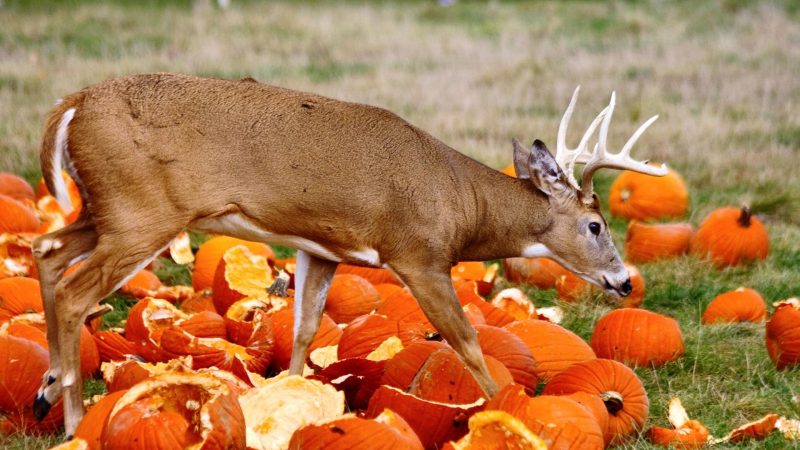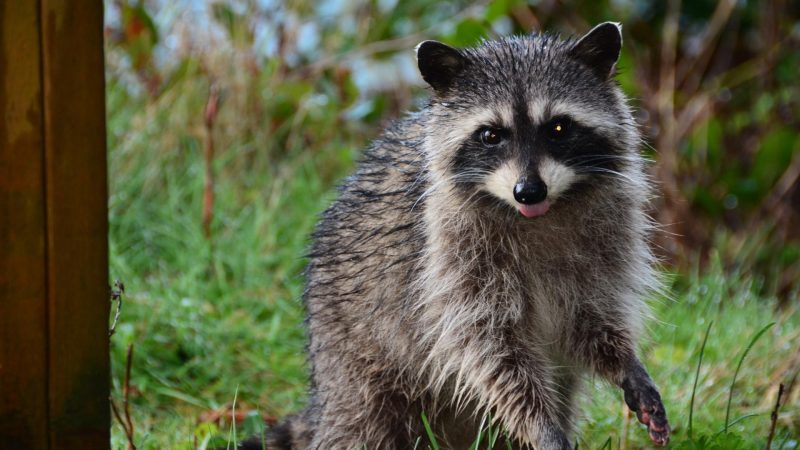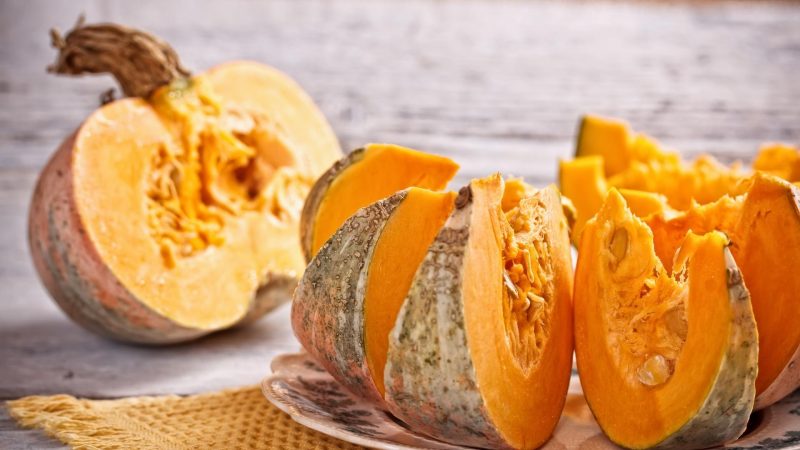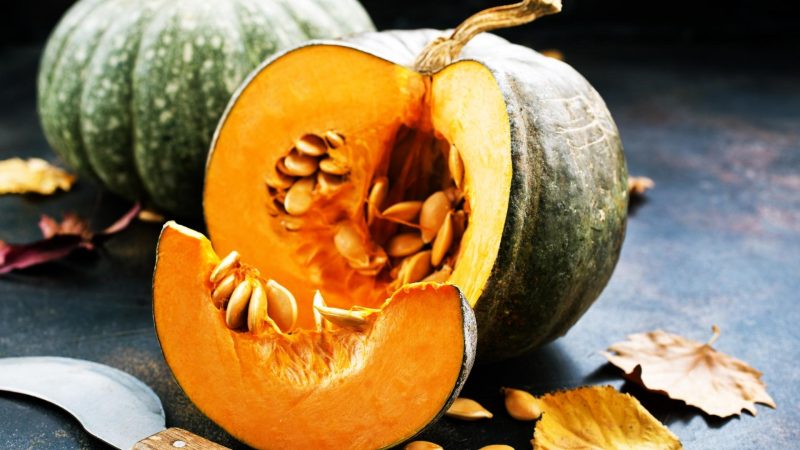In winter, deer venture to a wider area to lower the food competition and escape the risk of predation. Its diet depends on food plants with the support from synthesized microbial symbionts that live in its stomach.
There’s more to learn about the diet of this animal, and this article will show them to you.
Do deers eat pumpkins? Deers eat pumpkins just like other wildlife. Specifically, they prefer chewing the guts or the squishy rind rather than the shell. Hence, it would be easy for them to eat a pumpkin when it’s open. They also like to munch on pumpkin leaves in summer and eat ripe pumpkins in the fall. Moreover, flowers and seeds are edible for deers too.
When Halloween is over, there’s a ton of pumpkins lying around. However, feeding a deer can lead to predation, starvation, disease, and vehicle accidents based on the statement of the Fish and Game Department of the University of New Hampshire.
Even so, deers can find their way to pumpkins. They even cause damage to farms, and pumpkin is one of their common targets.
You may wonder about the real score on the deer’s eating habits and pumpkin consumption. Just continue reading to feed your curiosity.
Table of Contents
Do Pumpkins Attract Deer?

Pumpkins attract deer since this animal eats both the plants and the pumpkin itself. Some garden owners who grow pumpkins sometimes need to chase a deer that attempts to feed on their plants.
Just the scent of pumpkin is so attractive to the deer. Even the fresh pumpkin leaves are irresistible for the deer, so it’s normally drawn to pumpkin fields in summer.
Apart from pumpkins, deer eat a variety of foods such as acorns, beans, corn, evergreen plants, and cultivated vegetables.
So, you’ll sometimes see deer that ignore pumpkins as their attention is on other kinds of food. It will likely happen when this animal is in starvation mode.
What Are Pumpkins?
As confirmed by Jenna Anding, Ph.D., pumpkins are technically fruits rather than vegetables since they grow botanically with flowers. They’re healthy as they contain Vitamin C, water-soluble Vitamin A, potassium, and beta carotene. Belonging to the Cucurbitaceae family, they’re one of the trailing vines that come from Central America.
The content of pumpkins is 92% water. Aside from being a food source for humans and animals, they can be made into medicine. There are around 45 varieties, and they differ in colors.
Besides the usual orange type, you can see pumpkins in green, yellow, orange, and red. Some of them are called Cotton Candy, Hooligan, and Orange Smoothie.
Are Pumpkins Healthy for Deer?

Pumpkins are healthy for deer because they are rich in Vitamin C, potassium, and fiber content. With these vitamins and minerals, there’s no doubt that they provide nutrition to the animal.
Nutritional Benefits of Pumpkin
The fiber from the pumpkin guts can strengthen the deer’s bones. When a deer eats pumpkin seeds, it can get a supply of fat which they can store and use for winter.
They can eat more to obtain more fat and survive the cold season. To maintain a healthy state, pumpkin also delivers potassium and Vitamin C.
Do Wild Animals Like Pumpkins?

Wild animals like pumpkins. As long as the pumpkins are not coated or painted, they’re safe for the animals. There’s even a pumpkin-feeding tradition at zoos in the United States.
It’s linked to Halloween-themed parties. Instead of just using the pumpkins for decorations, they are directly given to the zoos.
Those who use pumpkins for decoration during Halloween won’t have a problem with disposal. Squirrels are usually the first animals that attack a pile of pumpkins. But it differs from place to place.
Some people would cut pumpkins and scatter the pieces all over the yard so squirrels can pick them up. Other wild animals are also eager to eat them, and deer is one of them. Raccoons, porcupines, and opossums like pumpkins too.
Birds like cardinals, catbirds, and mockingbirds love pumpkin seeds. Still, squirrels come into the picture as they eat more seeds than these birds. Snakes and bats can bite on every part of the pumpkin.
But, large animals like elephants just ignore a pumpkin that weighs a thousand pounds. Some of them may eat it, but they smash the pumpkin first.
Can Deer Eat Raw Pumpkin?

Deer eat raw pumpkin as long as it’s ripe because it takes a bite once this animal finds this plant.
What Types of Squash Deer Enjoys?

Deer can eat squash that is not thorny and hairy. It doesn’t enjoy eating squash as much as eating pumpkin guts. Therefore, it will likely give its attention to squash when it’s starving.
How to Keep Deer Away From Your Pumpkin Garden?
Deer take their time to eat a lot of food in spring, summer, and fall. In the growing season, an adult deer can consume 6 to 10 lbs of food daily. Many think that this animal is a grazer, but it’s not since it can’t efficiently digest grass.
But new shoots can properly break down in their stomach. Thus, it can damage the crops including pumpkin, as it searches for food for winter preparation.
It’s easy to determine that the deer is the culprit by its cloven-hoof tracks. Unlike rabbits and woodchucks, it tends to tear the plants.
It usually gnaws on the pumpkin and leaves it to rot. To keep it away from your pumpkin, the solution is to put up a fence.
Fencing
The fence that you can set up is a long-term barrier between your garden and the deer. It’s the most effective solution, but you need a good and relative plan before building it.
For instance, it’s a piece of cake for a deer to jump over 10 feet of the fence, but it’s not something that it chooses to do. Deer prefer to enter your garden by going through or under a fence.
Electric Fence
Since deer don’t jump over the fence, you need to place the bottom wire that is not more than 10 or 12 inches away from the ground. The adult deer is around 36 inches tall until its shoulders.
Thus, the second wire should be 30 to 36 inches tall in a three-wire fence. With three wires, you can set them in the heights of 12, 24, and 40 inches tall.
A portable electric fence can be availed, and you can put it up and remove it whenever you want. If you own a bigger farm or orchard, a permanent fence is the best option. It can be costly but you can save money by clearing the perimeter and using a solar charger.
To warn the deer from attempting to get inside your farm, you can put a bit of peanut butter. When the tongue and nose of the animal touch it, the wet parts will be in electric shock. So, the deer will have an idea that it needs to keep out from the fence.
The bait needs to stay for a couple of weeks to educate the deer to refrain from getting into your garden. Then, you can take it off once the animals are fully aware of it.
When choosing the posts for the fence, they don’t need to be stout. You can choose fiberglass posts and let each stand with a 30 to 40 feet gap from one to another.
Non-electric Fence
Since a non-electric fence is not a behavioral barrier like the electric one, it’s constructed differently. It should stand 8 feet tall and you can choose from two styles which are mesh and smooth wire strands.
Tension is crucial in this fence because it works as a deterrent. Make sure to secure the posts and construct the corners with a lot of care. No electricity can threaten deer, so nothing can stop them from pushing the fence.
There are various fence designs. In standard wiring, the distance between wires increases as the fence gets higher. Deer prefer to pass through the fence or under it, so the lowest strand should be not more than 6 inches away from the ground.
The space between the wires needs to be around 15 to 20 inches. This is recommended for the fence that is over 4 feet. For the fence below four feet, the spacing shouldn’t be more than 10 inches.
Deer Repellents
The repellents that you can buy in the market make the crops like pumpkin smell and taste unpalatable to the deer. To set your expectations, these repellents are only for reducing the damage to your garden or farm. They don’t eliminate deer damage.
The repellent must be applied consistently to see the best result. You can try using Bobbex Ready-to-use Deer Repellent, Deer Out, and Liquid Fence. If you compare repellent to fencing, the latter is more effective.
Summary
Deer eat pumpkins, and its favorite part is the gut. Thus, those who grow pumpkins have to build protection not only from deer but other wild animals as well.
Pumpkins are good for deer since they’re packed with nutrients like potassium, fiber, beta carotene, Vitamins A and C. If you have a pumpkin to spare, you can place it in an area where deer and other animals can access it.
List of Sources
More Harm Than Good: Why You Shouldn’t Feed Deer. University of New Hampshire.
Muntean, L. (2019). Pumpkins are, in fact, a healthy fruit. Texas A&M AgriLife.
McDonald, J. E., Hollingsworth, C. S. (2013). Preventing Deer Damage. University of Massachusetts Amherst.
Oliveira, R. (2018). 10 things you probably didn’t know about pumpkins. University of California.